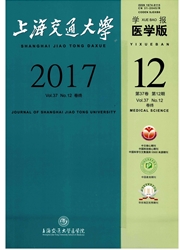

 中文摘要:
中文摘要:
目的 · 从多囊卵巢综合征患者卵泡液中分离提取外泌体并进行鉴定,明确卵泡液中外泌体的存在;从外泌体中分离提取 miRNAs 并检测其表达量。方法 · 利用膜亲和法提取卵泡液中外泌体,透射电镜观察大小和形态;利用流式细胞仪检测外泌体蛋白标 志物CD63 和 CD81 的表达;提取纯化外泌体miRNAs,利用TaqMan 探针real-time PCR 检测miR-125b、miR-19b 和 miR-222 的表 达。结果 · 透射电镜下观察到卵泡液外泌体呈圆形或椭圆形,直径 30 ~ 100 nm,有完整的膜结构,内含低密度物质;流式细胞仪检 测外泌体 CD63 和 CD81 呈阳性表达。Real-time PCR 检测到外泌体中 miR-125b、miR-19b 和 miR-222 的表达。结论 · 多囊卵巢综合征 患者卵泡液中可以收集到外泌体,可以通过电子显微镜和流式细胞仪对卵泡液中的外泌体进行鉴定。卵泡液外泌体中含有 miR-125b、 miR-19b 和 miR-222。
 英文摘要:
英文摘要:
Objective · To extract and identify exosomes in follicular fluid from patients with polycystic ovary syndrome in order to determine the existence of exosomes in follicular fluid, to isolate and extract miRNAs in exosomes, and to detect relative expression of miRNAs. Methods · Exosomes in follicular fluid were collected with membrane affinity chromatography and their size and morphology were observed with the transmission electron microscope. Exosome protein markers CD63 and CD81 were detected with flow cytometry. miRNAs in purified exosomes were extracted and expressions of miR-125b, miR-19b, and miR-222 were measured with TaqMan real-time PCR. Results · Exosomes in follicular fluid were circular or elliptic under the transmission electron microscope with diameters of around 30-100 nm. They had complete membrane structure and contained low density matter. Flow cytometry showed that CD63 and CD81 were positively expressed in exosomes. Real-time PCR detected expressions of miR-125b, miR-19b, and miR222. Conclusion · Exosomes can be collected in follicular fluid from patients with polycystic ovary syndrome. Transmission electron microscopy and flow cytometry can be used to identify exosomes in follicular fluid. miR-125b, miR-19b, and miR-222 can be detected in exosomes.
 同期刊论文项目
同期刊论文项目
 同项目期刊论文
同项目期刊论文
 Successive and cyclic oral contraceptive pill pretreatment improves IVF/ICSI outcomes ofPCOS patient
Successive and cyclic oral contraceptive pill pretreatment improves IVF/ICSI outcomes ofPCOS patient 期刊信息
期刊信息
